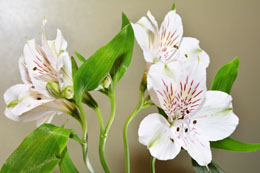When grown in groups, the bold-colored, showy Peruvian lilies become a showstopper in a flower garden. Read on to know more about the symbolism about this flower, and more info on cultivating it...

Peruvian lilies are also known as the lilies of Incas, parrot lilies, or by the name of their genus,
Alstroemeria. This genus encompasses about 50 species of flowering plants, which are mostly perennial. Altogether, there are about 190 varieties of Peruvian lilies, including hybrid cultivars. Taxonomically, the plant belongs to the family
Alstroemeriaceae of the order
Liliales. Though indigenous to South America, today this lovely flowering plant is cultivated in many regions of the world.
Meaning and Symbolism
Alstroemeria blooms symbolize true friendship and devotion. When exchanged between friends, they represent a long-lasting relationship between the sender and the recipient. These flowers are also gifted to wish good luck, wealth, and success, while starting out on a new venture in life. One of the identifiable features of all Peruvian lilies is the resupinate foliage. What this means is that what appears as the top surface of the leaves is actually the bottom, and vice versa. Inspect the plant a bit, and you will find the twist in the petiole at the base.
The twisting leaves of alstroemeria symbolize an everlasting bond between friends and lovers (due to the unavoidable twists and turns of life). These lilies are used for gifting in almost all occasions. Available in different shades of vibrant colors, their use in weddings is not new. Beautifully arranged bridal bouquets of alstroemeria are sold in most florist centers. One can even make personalized bouquets out of these showy blooms to be used in wedding floral arrangements. The long shelf life of these spectacular lilies stands for long-lasting devotion.
Cultivation and Maintenance
As you look for alstroemeria bulbs in nurseries, you will come across two basic types. The first is a winter-growing cultivar from Chile, and second is summer-growing cultivar from Brazil. To increase hardiness, hybrids are developed by crossing these two diverse alstroemeria cultivars. You should select the appropriate variety of Peruvian lilies according to the climatic condition in your area and soil type in your garden. Depending on the particular species, alstroemeria plants bloom in shades of white, peach, yellow, orange, pink, and red. You will also find a number of two-tone varieties.
- It prefers to grow in a sunlit area, and in a soil with no drainage problems. You can consider growing the bulbs in flower gardens, or as a part of container gardening. Provided that overwintering steps are followed properly, they are adapted in USDA hardiness zone 7 and below.
- Select a site that receives full sunlight for 4-6 hours daily, and proceed with soil preparation in spring or late winter. Consider adding organic compost several days prior to the plantation. If winter temperature is very low in your area, include them in your indoor gardening project, and prepare potting mix.
- You can plant these flowers in early spring. Purchase healthy and disease-resistant cultivars of desirable colors from a horticulture center. Dig a planting hole that is slightly bigger than the original pot. Place the plant in it without disturbing the bulb. Then, refill the soil and gently press it to get rid of air pockets.
- If you are planting groups of alstroemeria, leave a space of 6 inches or more between two plants. Deeply water the newly planted lilies, and follow regular irrigation in spring and summer. You can reduce watering in fall and winter.
- Fertilizer application with a balanced plant food (6-6-6 NPK) can be done in spring. As the plants become mature, they will develop flower buds in spring, summer, or fall, depending upon which cultivars you have planted. After the flowering period is over, deadhead the spent blooms (cut off the flowers at the stalk), while retaining the foliage.
You can plant this lily in separate pots as houseplants or in other garden sites. For some species, the blooms have a shelf life of more than two weeks.
Planting and maintaining Peruvian lilies is quite easy, once you get to know the basics. Good luck!






 Peruvian lilies are also known as the lilies of Incas, parrot lilies, or by the name of their genus, Alstroemeria. This genus encompasses about 50 species of flowering plants, which are mostly perennial. Altogether, there are about 190 varieties of Peruvian lilies, including hybrid cultivars. Taxonomically, the plant belongs to the family Alstroemeriaceae of the order Liliales. Though indigenous to South America, today this lovely flowering plant is cultivated in many regions of the world.
Peruvian lilies are also known as the lilies of Incas, parrot lilies, or by the name of their genus, Alstroemeria. This genus encompasses about 50 species of flowering plants, which are mostly perennial. Altogether, there are about 190 varieties of Peruvian lilies, including hybrid cultivars. Taxonomically, the plant belongs to the family Alstroemeriaceae of the order Liliales. Though indigenous to South America, today this lovely flowering plant is cultivated in many regions of the world.